Hi All! Thanks for being here, thanks for having me and thanks for taking a look at this.
I'm working on starting a music education project here in Athens GA and I'm building out a studio for it.
(you can find more details at https://www.thrilla… )
First off I need to say that isolation is not a problem here. Not that there aren't issues, but I can get around them and my neighbors are super cool. Plus the building itself is set way off the road on the end of a dead end street.
I've posted diagrams of the two rooms involved, but for now I'm focusing on the control room (Room B in the diagrams).
I've also posted the SPL results from REW for the room - it's an average of three tests. I'm new to REW and room acoustics, so I'm spending a lot of time in YouTube learning how to read the results. But if any more experienced folks want to give me some tips on how to make the room more neutral and appropriate for mixing/mastering/control that would be greatly appreciated!
You can also download the mdat file for the tests here: https:///www.thrillahill.com… (you might have to right-click and select "save as" to get that to work).
I'm sure I left a lot of stuff out of this but please feel free to unload with any questions you might have!
Thanks again,
Will.
Comments
I got a bit confused with the aims of the project - the three co
I got a bit confused with the aims of the project - the three core projects. I couldn't quite understand what the aim actually is? music production for the local community? So a social thing, or career thing for young people, or what exactly? I also kicked myself when I thought the design didn't look very Greek and wondered how well the Greek speaking community would fit into a community project, then I spotted a couple of spellings and realised Athens is in the US, in a State called GA - so my fault.
Good luck with the project.
kmetal, post: 461597, member: 37533 wrote: Hey welcome to RO. I
kmetal, post: 461597, member: 37533 wrote: Hey welcome to RO.
Im not an expert on reading charts, but ive built several pro studios. Generally there isnt much to read into when the room is untreated.
The most critical area in the CR especially is low frequency response. For this youll want to use a mode calculator to identify which low frequencies overlap with each other, or arent spaced well.
I can do this in REW, I just need to brush up on how :) I'll poke around and get back to you.
kmetal, post: 461597, member: 37533 wrote: I would strongly consider using the larger room for the Control Room. You can reproduce lower bass frequencies in that room, which is critical for mixing and getting sounds. The tracking has the luxury of moving the mics and instruments around to get the desired response, as well as eq.
I've flip-flopped over that for months now. The fact is I'll probably end up using both rooms for both purposes depending on what's going on. Perhaps some use-case scenarios would help:
The first project I hope to launch (and soon-ish) is a local singer/songwriter podcast where artists come in to the studio and play a few songs and we talk about the craft for a little while afterwards. For this I'd like to use the rooms as they are with the larger room to record. I'm an old theatre queen myself and I know how important "the space" can be to a performer. It's no contest between the two rooms in that regard.
But then I'm hoping to launch a music for video games program this winter. In that scenario we would set up the control room gear in room A just because we'd need all that room in order for six to eight people to collaborate.
I'm reading Built It Like The Pros now but I also read a couple of other books and given the total volume of the rooms my goals became to make the tracking room as best *possible* for recording acoustic guitar, voice and violin. I emphasize "as possible" because I know it's a bit of a pipe dream. After that I'd make the best use of Room B as I can, but mostly treat it for control.
For better or worse, I've made my peace with that strategy ;)
kmetal, post: 461597, member: 37533 wrote: The biggest problem with your dimensions is the 8ft ceiling. In both rooms i would expect to add absorbers (a ceiling cloud) that covers most of the ceiling.Your going to want as much bass trapping as possible in the CR, for sure. Ideally in the tracking room too.
Beyond the ceiling cloud and bass trapping, basic RFZ (reflection free zone) treatment is the most conmon approach these days. You sit at the listening basic position (38% deep into the room, centered left to right), witg the speakers set up in sn equilateral triangle off that point. have a buddy slide a mirror along the walls, and anywhere you can see the tweeters, mark as a location for absorption.
In general 25-30% of the room treated with absorbsion yeilds something thats not uncomfortably dry or wet sounding.
I was thinking all of this as well, but hoping to not have to treat the ceiling. I'm 6'3", I simply hate to lose the space. But I will do it as soon as the budget loosens up a little. I'm going to get started on absorption panels, I have a woodshop right next door so I can build to suit without too much hassle. The only thing is I'm having trouble sourcing 2x4 pieces of R- insulation. So my plan is to actually build 45" x 45" panels that I can use the 15" batts in. Any thoughts here would be greatly appreciated!
kmetal, post: 461597, member: 37533 wrote: The tracking room has more options. Maybe one side live-er the other side deader. It depends much more on taste, and what your tracking in there, and if its live groups. Once the basic bass response and nasty slap echoes and rings are taken care of, much of it is then done by ear.
Hopefully I'll get some response to my singer / songwriter project and we can start recording some instruments / voices and really get into all of that. But I agree that taming the echoes and rings will come first. I'll fire up the saws and nail guns and let you know what happens.
kmetal, post: 461597, member: 37533 wrote: These are fairly general answers to the broad questions.
And they are GREATLY appreciated, thank you so much!
kmetal, post: 461597, member: 37533 wrote: I highly reccomend "build it like the pros" by Rod Gervais, as the defacto guide for anyone building a studio.
I would also add that proper, quiet electricity and lighting are critical. I would also consider some sound isolation in case the neighbors change their mind or new ones move in.
I'm on it, I've replaced the ballasts but I'm also trying to get some non-noisy track lighting installed for actual recording sessions. Yeesh, so much to cover...
Thanks again!
paulears, post: 461598, member: 47782 wrote: I got a bit confuse
paulears, post: 461598, member: 47782 wrote: I got a bit confused with the aims of the project - the three core projects. I couldn't quite understand what the aim actually is? music production for the local community? So a social thing, or career thing for young people, or what exactly?
I'm really still muddling through the answers to those questions TBH. But one thing I've settled on is that I hope no matter what program a person participates in they leave knowing exactly what they can accomplish in their bedrooms and exactly what a studio is required for. Then I hope they'll know enough, and have the confidence, that when they do spend money on studio time they can use that time as efficiently as possible.
But mostly I'm looking for a space that may not sound "good" by professional standards but has its own unique sound that's not really "bad" either. I don't know how to describe it, but I've heard it before and I like to take a shot at it.
paulears, post: 461598, member: 47782 wrote: I also kicked myself when I thought the design didn't look very Greek and wondered how well the Greek speaking community would fit into a community project, then I spotted a couple of spellings and realised Athens is in the US, in a State called GA - so my fault.
Good luck with the project.
Athens GA was once home to some bands called R.E.M. and the B-52s, so we still claim to be a "music town" near Atlanta. But mostly it's just a bunch of nostalgia bands rehashing two electric guitars, electric bass, and beat to death, out of tune, acoustic drums.
I'm seeking the refugees and outcasts of that world.
Ha! I got excited a few weeks back when people were posting from
Ha! I got excited a few weeks back when people were posting from a couple of miles up the road, then I discovered that they too were in the US!
My viewpoint on educational projects is biased by my years teaching it in college, but I'd go light on expensive audio solutions and spend money on some very odd things. I turned around the wall sheet material to have the plasterboard on the stud work side and finished off the inner face with MDF, with the sheets horizontal, and the gap finished by a 4" x ½" strip, with another parallel to it below, with power outlets and audio rocketry in the gap. The reason is that with office chairs and plenty of time, people constantly wore grooves into the plasterboard - young people just scoot the chairs around the room! The absolute quality of the audio is always good nowadays, so over treated rooms, making them deader than ideally we'd want in a pro facility can be nicer to work in with groups, and you can liven it up artificially. Spending money on top end kit can be better spent on more kit. So two cheaper mics wins over one expensive one - that kind of stuff.
Don't skimp on air handling. With projects you often end up with more people in the room than ideal, so more money on cool healthy air is well spent. Above all - space is the key. You could even be a bit radical. your total space is quite big. How many times will you have a drum kit being used? I've already decided that if I have a change of location, then my next studio space will be very different. One big space that is great to work in, with a very small vocal booth. If I record drums it's now very rare, and my half and half current design leaves me working with perhaps one or two others in half the space and the other room full of junk! For teaching and people projects, one big room can be so much more useful, and you get used to tracking with headphones when you have a band in.
Just a thought..........
Will Leamon, post: 461600, member: 51648 wrote: The only thing i
Will Leamon, post: 461600, member: 51648 wrote: The only thing is I'm having trouble sourcing 2x4 pieces of R- insulation. So my plan is to actually build 45" x 45" panels that I can use the 15" batts in. Any thoughts here would be greatly appreciated!
You can use 2x4' rigid fiberglass panels. You can also use 24" wide R- value made for 24" stud spacing. You can make a basic stud frame and hang it from the ceiling. You can also use 2" acoustic foam if ceiling height is a concern.
Will Leamon, post: 461600, member: 51648 wrote: I can do this in REW, I just need to brush up on how :) I'll poke around and get back to you.
You can also use a room mode calculator.
paulears, post: 461602, member: 47782 wrote: Spending money on top end kit can be better spent on more kit. So two cheaper mics wins over one expensive one - that kind of stuff.
I highly disagree. A couple of choice peices are all you need in many cases. There are affordable choice peices that arent a compromise based on price. The focusrite isa pres and Neumann tlm 102 are prime examples. Or a shure sm 57.
Mediocore + medicore = mediocore.
paulears, post: 461602, member: 47782 wrote: one big room can be so much more useful, and you get used to tracking with headphones when you have a band in.
This a agree with. Id err towards a single larger room in the OP's case.
I'm absolutely rigid in my view that for education for people at
I'm absolutely rigid in my view that for education for people at the entry end, the very last thing to spend money on is exotic preamps and Neumanns. I've seen my fill of destroyed nice microphones, because the XLR cable was 3 ft short, crossed the room at ankle height and the stand crashes to the floor. Student ears are also not trained sufficiently to detect these differences. As sound quality increases more slowly as prices go up, we're talking to people who have not noticed the enormous hum, or that they're singing into the back of the microphone - so when you have a limited budget, individual expensive items are not needed at all. Of course, many of the teachers want access to these pieces of kit, and that is why they are specified in the budgets. I'd rather have ten sm57s than one Neumann. In fact, the initial mic box for education needs to encompass cheap stuff that's just about effective as the foundation, then better kit for those who have proven their competence. I cannot conceive that any microphone costing more than say £400/$500 dollars would be useful. In these kinds of studios, the acoustics and occupants make top end work unlikely. For the owner, lovely to have, but in all my years of educational music from 14 to retirees, the best music recordings from all over the UK did not feature top end gear at all, it featured people with good aural ability. The places with studios full of wonderful kit usually produced one good piece of work, but the others, using the same kit, produced rubbish - often because they put the good kit in the wrong places, with the wrong eq, with the wrong balance. Nothing will shift my opinion. Thousands of pieces of exam work came through my hands, and I monitored very carefully the relationship between kit and quality, and I'm not convinced there is one.
paulears, post: 461611, member: 47782 wrote: I'm absolutely rigi
paulears, post: 461611, member: 47782 wrote: I'm absolutely rigid in my view that for education for people at the entry end, the very last thing to spend money on is exotic preamps and Neumanns. I've seen my fill of destroyed nice microphones, because the XLR cable was 3 ft short, crossed the room at ankle height and the stand crashes to the floor. Student ears are also not trained sufficiently to detect these differences. As sound quality increases more slowly as prices go up, we're talking to people who have not noticed the enormous hum, or that they're singing into the back of the microphone - so when you have a limited budget, individual expensive items are not needed at all. Of course, many of the teachers want access to these pieces of kit, and that is why they are specified in the budgets. I'd rather have ten sm57s than one Neumann. In fact, the initial mic box for education needs to encompass cheap stuff that's just about effective as the foundation, then better kit for those who have proven their competence. I cannot conceive that any microphone costing more than say £400/$500 dollars would be useful. In these kinds of studios, the acoustics and occupants make top end work unlikely. For the owner, lovely to have, but in all my years of educational music from 14 to retirees, the best music recordings from all over the UK did not feature top end gear at all, it featured people with good aural ability. The places with studios full of wonderful kit usually produced one good piece of work, but the others, using the same kit, produced rubbish - often because they put the good kit in the wrong places, with the wrong eq, with the wrong balance. Nothing will shift my opinion. Thousands of pieces of exam work came through my hands, and I monitored very carefully the relationship between kit and quality, and I'm not convinced there is one.
Ive seen my fair share of bruised mics and interns dropping stuff.
My point is generally, as soon as people mix in a room with good gear and acoustics, they perform better instantly on lesser gear. Theres 100s of thousands of commercial level audio recordings, done by 10s of thousands of engineers, are they all golden eared? Or did they just not screw it up with a neve and a good room.
For daily use 57s are fine. But to have not at least one akg, or nuemann, or one neve, of which a commercial studio considers 'standard' is inadequate. First you cant assume all students are at the same level, and you have to get them to be able to hear the differences between a top end piece and otherwise. Nuance is the name of the audio game.
Otherwise where does it stop? We set students up on a 60$ berringer interface, 15$ Amazon condenser, a pair of samson speakers, and track directly to mp3? Then what tell them to mix out the upper mid gross-ness and bass they cant hear on the speakers?
What about when your new expensive condenser reveals how terrible your room sounds?
I learned exponentially faster in 5 years at a commercial studio, than the previous 15 years on my own at home. I dont think im alone in that.
Dings and repairs are a cost of doing buisness. Shilling out 'pro audio' lessons on sub par gear is a dis service. A 57 and eureka channel is great entry level gear. Compared to a 441 and a manley, they are different levels, and students must be taught to hear the differences. Even if they're skill set does not allow them to manipulate that difference, they must know that there is one.
It works both ways. Everyone thinks they want a neumann condenser, until they discover its about proper pairing with the source, not the mic alone. You can cure some GAS of which beginners are more inclined to get from marketing hype.
I'd go for at least 1 or 2 multipattern condensers to show diffe
I'd go for at least 1 or 2 multipattern condensers to show different pickup paterns. This is good knowledge to learn.
If budget is low, a mixer with at least 2 good preamp.
Yes, most students won't hear the difference specially if you can't make them ear it. Like K, I learned a lot more since I got nicer pres, mics and monitors.
But of course, the OP needs to stay realistic, if nobody invest cash in his project, it'll be very hard to buy what the place need to work.
Getting some sponsors and/or community founding would be a good thing to start off.
You can either teach how gear works or how sound works (which is more profitable on the long run)
In this case I suspect it's going to be a bunch of people doing collabs on various project more than a recording school.
The business model of many studios is changing from being payed by labels to record to community service, education and gear publicists.
Look at what Weathervane Music does : https://www.youtube…
paulears, post: 461617, member: 47782 wrote: My experience is th
paulears, post: 461617, member: 47782 wrote: My experience is the reverse. They don’t perform better on good gear until they have considerable experience and short courses are more pleasure and leisure experiences
I get you Paul, it depends on the seriousness and how long the courses last. I agree with you that on a 1 day deal, those who will hear the difference will be very few.
I think the OPs mind is not yet set on what his place will offer.. I hope he stick around so we can follow the development and end results...
I rather like the idea of this. We do community music projects h
I rather like the idea of this. We do community music projects here in the UK and I’ve designed quite a few For various organisations but the actual standard is alway geared to beginners. The first one I designed ran aground badly when half the people booked on it turned out to be computer illiterate and the others were ok with computers but had few musical skills. Course two was good because it was refocused to these people’s needs.
On the question of gear I feel, as someone who's done community
On the question of gear I feel, as someone who's done community art for almost 30 years now, that it's always great to give people an opportunity to work with fantastic gear. On the other hand less / inexpensive gear can drive a certain kind of innovation which is also valuable. I've always tried to just be grateful for what I've got and share that gratitude with others. A bit airy-fairy I know but it's served me well. For the record though we have a Tascam 16x08 interface / pre-amp, sm57s and 58s. I agree a good condenser vocal mic is vastly important but mostly to assuage vocalists' insecurities more than anything else. I will take care of that as soon as the rooms have been treated.
The programs offered will be for absolute newbies and up. It's not a classroom environment but project based. More like community theater than an art school. We live and die by the audience's support of our projects and I have never charged program fees to participants. No one's shilling anything here.
I'm not interested in recording bands in the space, my town has numerous professional recording studios run by some great people, all of who are struggling very seriously with staying afloat. I have no intention of competing with them or stealing their business.
Now then back to acoustics!
I'm starting work on the WB absorbers I think we all agree should be the first thing to go up. I've elected to use this for the insulator. I hate working with the fluffy pink stuff and I can get this at the local big box. I've gotten over my issues with height and will bolt a some to the ceiling. I was going to start with panels on the wall immediately behind the monitors, then the mirror-test, 1st reflection spots on the flanking walls and then at least two or three more on the ceiling. I'm hoping that will tame early reflection issues and maybe tame an overall "brightness" I'm hearing in the room. I'll get it to 30% coverage as soon as I can.
So I've spent more time with REW training and ran a much better batch of tests. Here's the full frequency response of the room (these are an average of 15 tests over 5 different spots, test SPL was around 80db).
Given the Alesis monitors I have aren't that great, I'm ok with what I'm seeing even though the high end is dropping off pretty badly. I'm assuming a lot of that is just the speaker design (though I am very new to this) but clearly something crazy is going on in the low end.
So here's the 20 - 500 Frequency Response chart:
I'm guessing that hump around 100 to 140 might be the ceiling and the wall fighting each other? Any thoughts on how to tame that would be great. Also I'm wondering about that dip around 340 and should I worry about it.
I'm a little surprised by those graphs - especially the full spe
I'm a little surprised by those graphs - especially the full spectrum one. I've never known a room that flat? Are you certain your plots are correct? What I mean is that with parallel surfaces and a low ceiling I'd expect all sorts of peaks and troughs, yet yours is a very gentle curve dropping only by around 15dB, very controlled and gradual. The dip at 340 is probably hardly audible - and with a curve response like this, eq'ing it flat would seem to be a very simple task. In fact, if I applied your curve to my own hearing top limit (being old), it's hardly worth calling it falloff, but just nearly flat!
You mention it is the result of averaging? how peaky/troughy were the individual traces? I'm assuming this was pink noise derived or a swept tone? I just can't believe there are no resonances at all? With a swept tone, I have a nasty collection of small ones and one big one just above 220Hz, which I have to notch out.
Will Leamon, post: 461623, member: 51648 wrote: I'm guessing tha
Will Leamon, post: 461623, member: 51648 wrote: I'm guessing that hump around 100 to 140 might be the ceiling and the wall fighting each other? Any thoughts on how to tame that would be great. Also I'm wondering about that dip around 340 and should I worry about it.
I would not bother testing until the RFZ treatment is up. At least i wouldnt read much into it.
Once the mirror spots are covered, and the bass traping installed, then id measure. My reasoning is, i know im covering the mirror spots, and adding as much bass trapping as i can, regardless of what any graph says.
No room is going to be mix ready without treatment, and no room of these sizes would be record ready without treatment.
The bass booms and nulls are related directly to the room dimensions. Use a mode calculator and it will show you your trouble frequencies. Some resonators tuned to 90hz would work well, in addition to broadband trapping.
Here's the mode chart if anyone is playing along at home. Now, i
Here's the mode chart if anyone is playing along at home. Now, if only I can figure how to make use of it ;)
kmetal, post: 461630, member: 37533 wrote: I would not bother testing until the RFZ treatment is up. At least i wouldnt read much into it.
Once the mirror spots are covered, and the bass traping installed, then id measure. My reasoning is, i know im covering the mirror spots, and adding as much bass trapping as i can, regardless of what any graph says.
No room is going to be mix ready without treatment, and no room of these sizes would be record ready without treatment.
The bass booms and nulls are related directly to the room dimensions. Use a mode calculator and it will show you your trouble frequencies. Some resonators tuned to 90hz would work well, in addition to broadband trapping.
Your room modes are the largest indicator of sonic quality of a
Your room modes are the largest indicator of sonic quality of a room.
The two key factors are what frequencies, and how are they spaced. The frequencies tell you what tones are going to be exaggerated and canceled out. The spacing determines how evenly (or not) the problem frequencies are distributed. Spaced too closely and theyll boost each other, spaced too far apart and there will be holes in the frequency response.
Generally you want even, uniform distribution (spacing) of the modal frequencies. 10-20hz is a general good spacing. Any more or less becomes problematic.
The frequencies that are modes of the room, are frequencies you want to target with your room treatment. These frequencies need to be smoothed out since they will vary the most from place to place in the room.
As i suggested based on the measurements, if you tune a resonato
As i suggested based on the measurements, if you tune a resonator to 90-95hz you will be able to even out the first set of very closely spaced modes, as well as the neighborhood of 80hz, and 110hz. These are critical areas since the low E string on a guitar is around 78hz, subwoofer crossovers are often set at 80hz, and 100-120hz is the low range of a male vocal, generally speaking.
These are critical things to hear accurately, and they can make or break a recording.
Hey all, Quick update. Bass traps for the control room have bee
Hey all,
Quick update. Bass traps for the control room have been built and we're in the process of mounting them now. I hope to have that done tomorrow or Wednesday.
(Curse you day job!)
I'll replot those numbers tonight when I get home. Do you any specific range in mind?
Thanks again and happy Monday all!
W.
Will Leamon, post: 461653, member: 51648 wrote: Do you any speci
Will Leamon, post: 461653, member: 51648 wrote: Do you any specific range in mind?
Both the lower and upper frequency limits are fine for illustrating your point. It's how a linear frequency axis squashes the low end detail that makes it difficult to be sure of what's going on down there.
When you see the log axis plot, there's a possibility that you will need to re-measure using an increased density of measurement points to get a reasonable curve.
Here's the log view: 20 to 20 20 - 500 These are based
Here's the log view:
20 to 20
20 - 500
These are based on 15 tests over 5 different locations. The start was in the exact middle of the room and the other locations were six inches forward, back, left and right of center.
Boswell, post: 461654, member: 29034 wrote: Both the lower and upper frequency limits are fine for illustrating your point. It's how a linear frequency axis squashes the low end detail that makes it difficult to be sure of what's going on down there.
When you see the log axis plot, there's a possibility that you will need to re-measure using an increased density of measurement points to get a reasonable curve.
Great! Thanks for doing that. It really puts a spotlight on the
Great! Thanks for doing that. It really puts a spotlight on the low end.
I'm an electronic engineer, not an acoustician, and there are many on this forum far better qualified than me to give a detailed analysis. However, the high mids look as though you may have some flutter echo still present, probably from sound bouncing between parallel surfaces. The real problem is the bottom end, particularly the double peak around 130Hz. The room is also falling off at 90Hz, which is a bit high for getting balanced mixes that would affect the definition when you have different instruments going on down there. I'm thinking of the times you need, for example, to balance bass guitar against kick drum, keeping them audibly separate. With a room response falling off at the same time, there is a danger of the resulting mix hving too high a level of bass in it.
Thanks for the input. Just to clarify these measurements are of
Thanks for the input. Just to clarify these measurements are of the room naked with no treatment. I've got just half the bass traps up and it already sounds way different in here.
I'll post a second round of measurements when the traps are in and the RFZ is done.
Boswell, post: 461670, member: 29034 wrote: Great! Thanks for doing that. It really puts a spotlight on the low end.
I'm an electronic engineer, not an acoustician, and there are many on this forum far better qualified than me to give a detailed analysis. However, the high mids look as though you may have some flutter echo still present, probably from sound bouncing between parallel surfaces. The real problem is the bottom end, particularly the double peak around 130Hz. The room is also falling off at 90Hz, which is a bit high for getting balanced mixes that would affect the definition when you have different instruments going on down there. I'm thinking of the times you need, for example, to balance bass guitar against kick drum, keeping them audibly separate. With a room response falling off at the same time, there is a danger of the resulting mix hving too high a level of bass in it.
In addition to Boz's concerns, i am also concerned about that 60
In addition to Boz's concerns, i am also concerned about that 60-70hz null. This will need attention so the sub bass is audible in your room.
Also worth mentioning is when your basic treatments are in, and your monitors set up, it is worth testing the response of the monitors themselves. This will help you differentiate between room anomalies, and speaker deficiencies.
In the first ed. of Rods book he describes how to do this. Not sure if the 2nd ed does, since the room test chapter was re-written.
The basic idea was to take the room readings, and shorten the window to like 5ms so what the plot shows is the sound from the speakers, before it has time to reflect off the walls and into the test mic. I think it involves a pink noise burst for to create the impulse response. Refer to the proper text for exact method, but the test is useful.
paulears, post: 461804, member: 47782 wrote: Ooh - there are som
paulears, post: 461804, member: 47782 wrote: Ooh - there are some very deep notches there at the low end. I can see kick and snare drums vanishing into some of those - right in that area. 50dB in half an octave. Needs some work on that one I think.
I see some deep notches on the center spot but they mellow out at the 12 and 24 spots. Currently I'm using the -24" spot as my chair's position. Am I not reading that right?
Will Leamon, post: 461801, member: 51648 wrote: The first round
Will Leamon, post: 461801, member: 51648 wrote: The first round of treatment is up and I've run a bunch of tests.
These first graphs are from the very center of the room:
Here's 12" back from center (away from the monitors)
And finally, from 24" back from center:
Are these tests done from the listener position? Did you set your speakers up as described in the book? Ie set your speakers in and equilateral triangle from the listening position (38% back in the room?) And a couple feet off the wall?
Its important we establish the testing shows the response of the speakers from a typical starting point.
Its also important to establish both the response of the speakers in the room, and the room itself.
Its necessary to measure the response of the sound before it has time to hit the walls and enter the test mic. This is where time gating comes into play. If you look at the impulse response for the first 5-7ms only, you get the direct sound from the speakers. (Im not an acoustics testing expert so the clear explanation is in rods book, in ed.1 for sure, not sure about ed2.)
This will help determine if for instance a sharp drop off in the low bass is due to the room mode or if the speaker itself doesn't have flat response that low.
If they are alesis speakers they probably have a 3"-6" low driver and would not push out alot energy in the low end.
We have to first establish the starting position of listener and speakers, take measurements, and then start moving the speakers around until the best response is acheived. I feel its possible based on those graphs, something is not right in the speaker and/or testing location.
As you move the speakers closer to a wall and corner you force t
As you move the speakers closer to a wall and corner you force them to put out more bass, and excite your rooms modes. So you use speaker position to tailor the low end to its ideal response.
For instance, if your listening postintion rests in a peak, moving the speakers away from the boundaries can lower the peak.
If your in a null, you would shift the listening position further forward or backwards to get out of the 'hole' in the response. And move the speakers accordingly to maintain the equallateral triangle.
Also, it is common to set the speakers up so they fire about 16" behind the listeners head. So if your 4 feet away from them, they would be 5'4" apart, aiming at a point 5'4" away from them.
The book is clearer on this than i have been. But thats the basic idea.
Also, it is typical to have the test mic head high (when seated)
Also, it is typical to have the test mic head high (when seated), pointing up at the ceiling, and the test mic should have an omni pickup pattern.
Its typical to test one speaker at a time when setting up the listening and speaker position.
We new 60hz and its octave 120hz were going to be an issue based on the modal spacing, and the fact that 60hz is the fundemental (lowest) frequency the room can physically reproduce.
Im referencing this chart that you posted.
Will Leamon, post: 461825, member: 51648 wrote: Testing was done
Will Leamon, post: 461825, member: 51648 wrote: Testing was done as you say: 35% off the wall, equidistant triangle set up, mic in the listener's position at (my) ear level.
So the 12" back and 24" back, are those distances behind the listening spot 38% back in the room? So 12" behind the 38% spot ect?
Are the speakers spaced off the wall? If so how much?
Is the ceiling cloud and wall treatments up?
Im just making sure because the measurements results dont look great for mixing. Im sure they can improve, just trying to picture what im looking at.
You can check out the room here https://706gaming.org/tire-swing
You can check out the room here https://706gaming.org/tire-swing-studio
Ok the clears some things up. The sharp drop off in the low end
Ok the clears some things up.
The sharp drop off in the low end i am attributing to the alesis elevates.
The big concern is the 30db jump between 70-100hz. This is a critical range, and 30db is gonna leave things too uneven to be fun to mix on.
Heres my thoughts.
Speakers:
I would try putting the speakers very close to the wall (in an equilateral triangle to mix location) This positioning can help reduce cancellations, and can boost sub frequencies due to being close to the room corners.
This what id do first. Together with your current set of measurements, the new set will outline the range of available response. Then you can find the best compromise of speaker and listening location.
Treatment:
You need much more bass trapping than is in the room. In addition to making the face of the traps larger, i would stuff the cavity behind with uncompressed insulation.
Then i would add bass traps along the wall ceiling junction.
The ceiling cloud should extend from behind the speakers to behind the listening position.
If its possible to space the wall panels furher off the wall this will help flatten bass.
Once the trapping, cloud, and speaker location is optimized, if the bass is still varying alot, it would be time to add tuned panel traps, and/or transform your bass traps to resonators by adding wood slats.
If its not too late id still consider making the studio a single room studio since you will get much better mixes and easier tracking.
If the entire 20x30 was available you could have nearly world class level room response without a ton of effort.

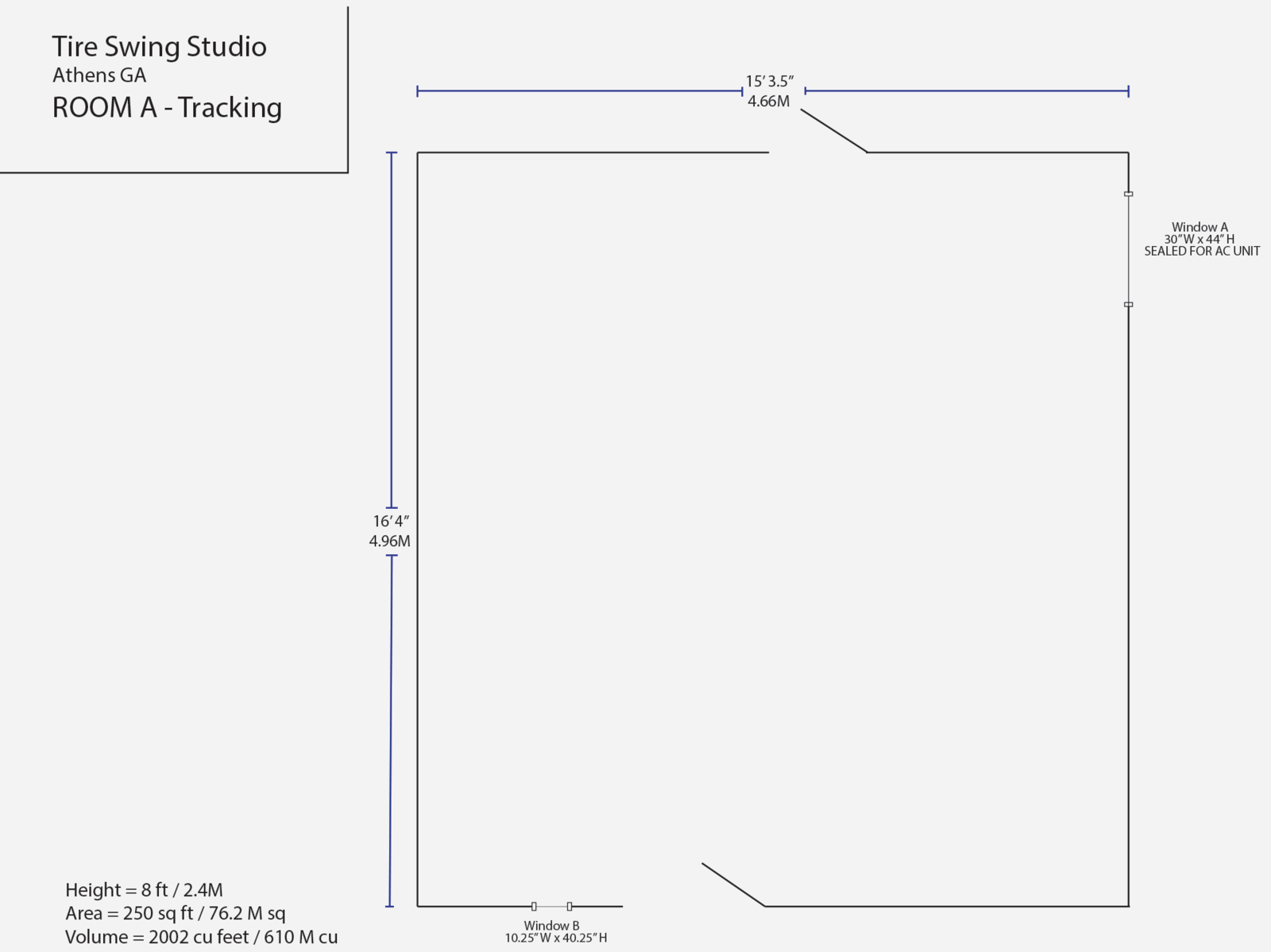
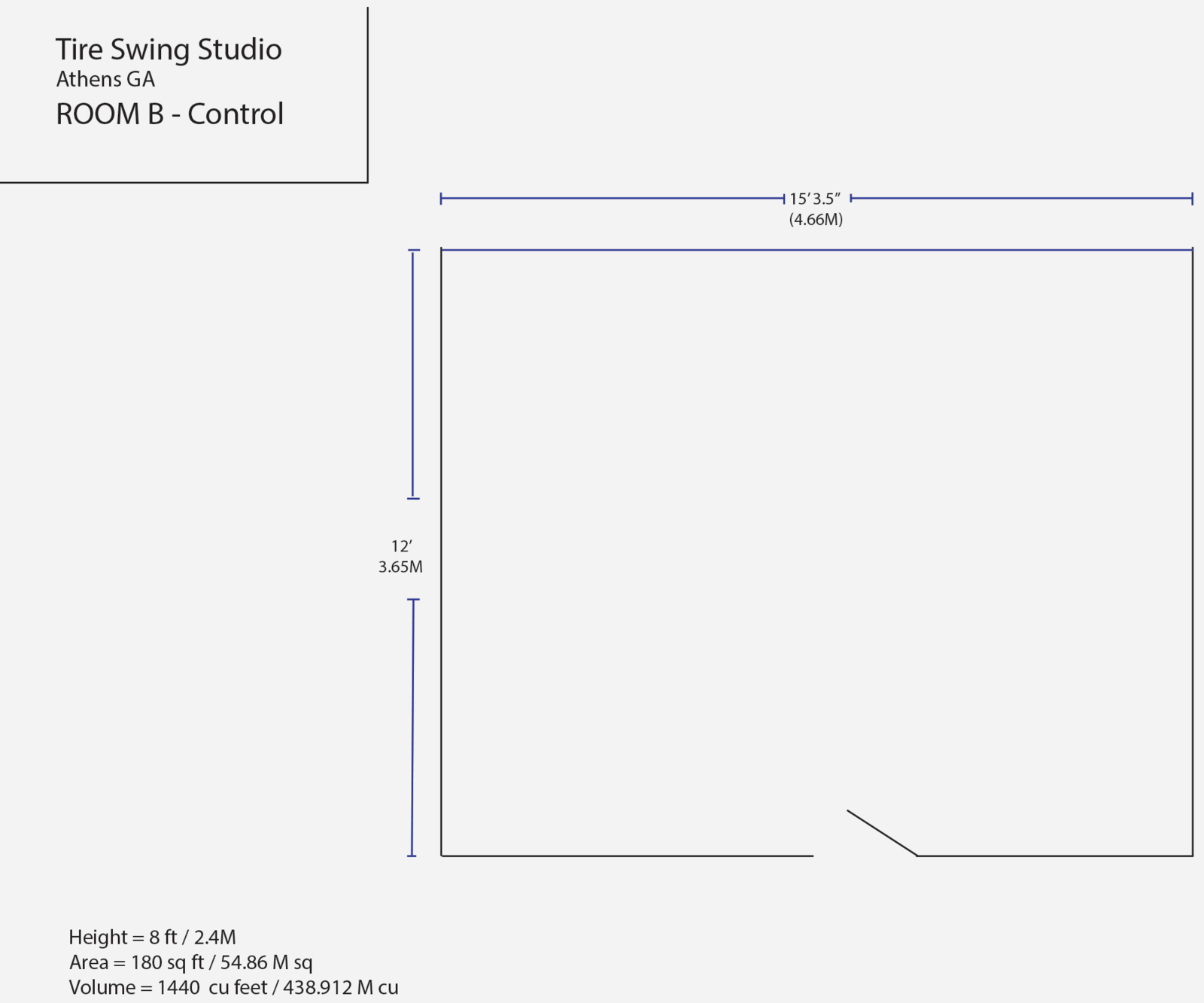




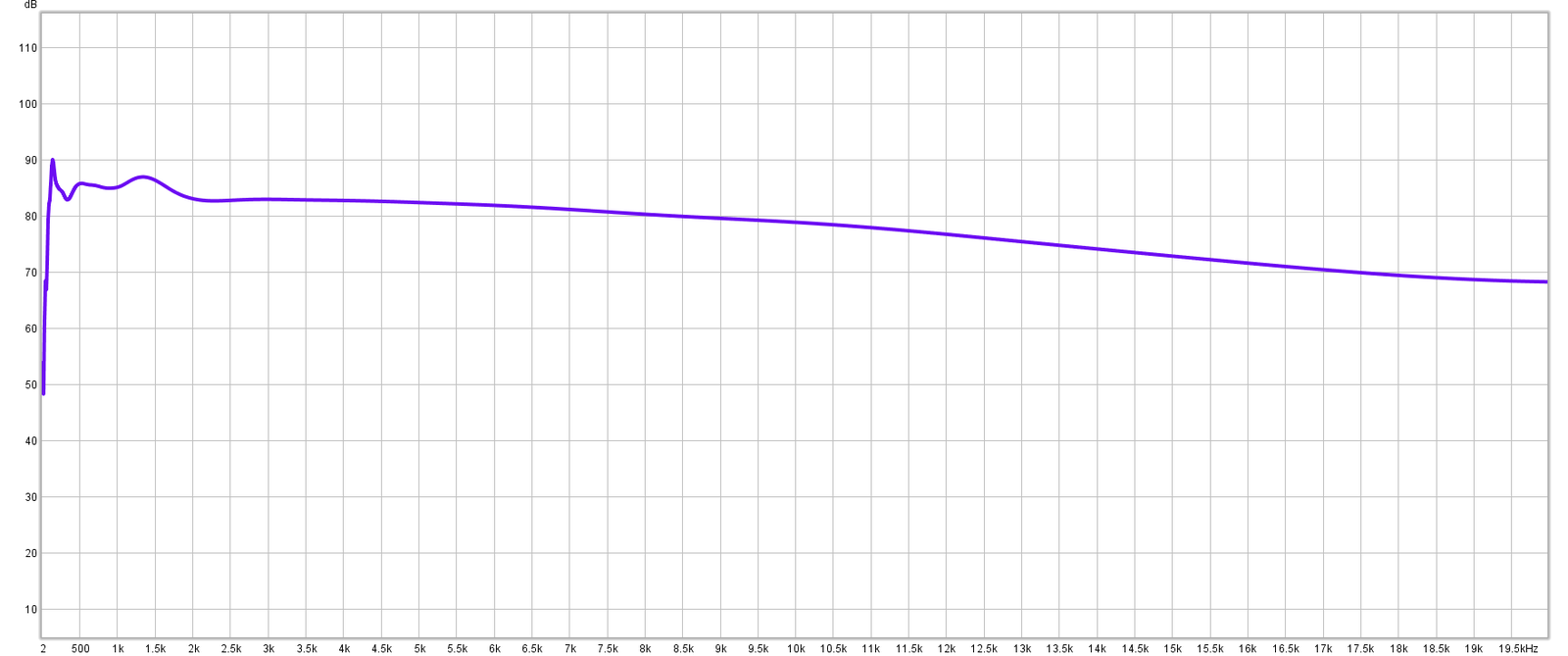
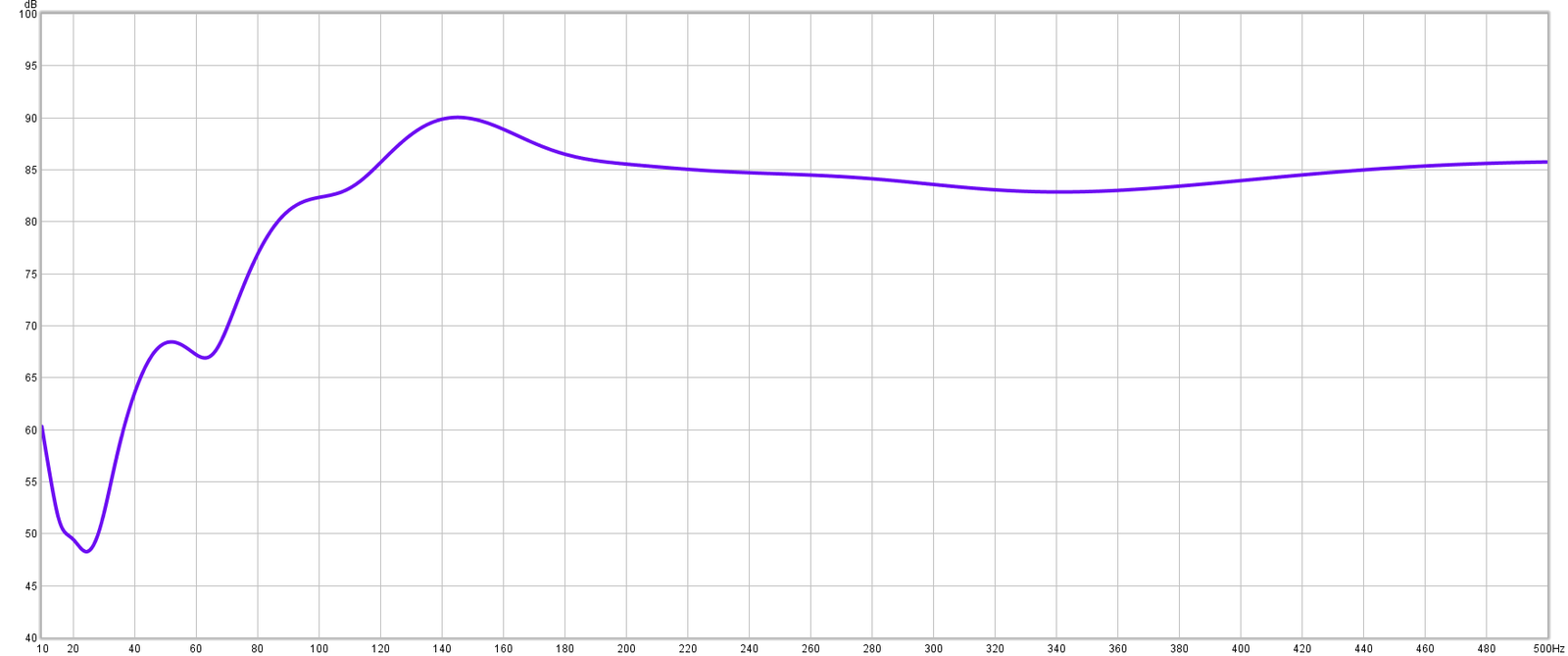
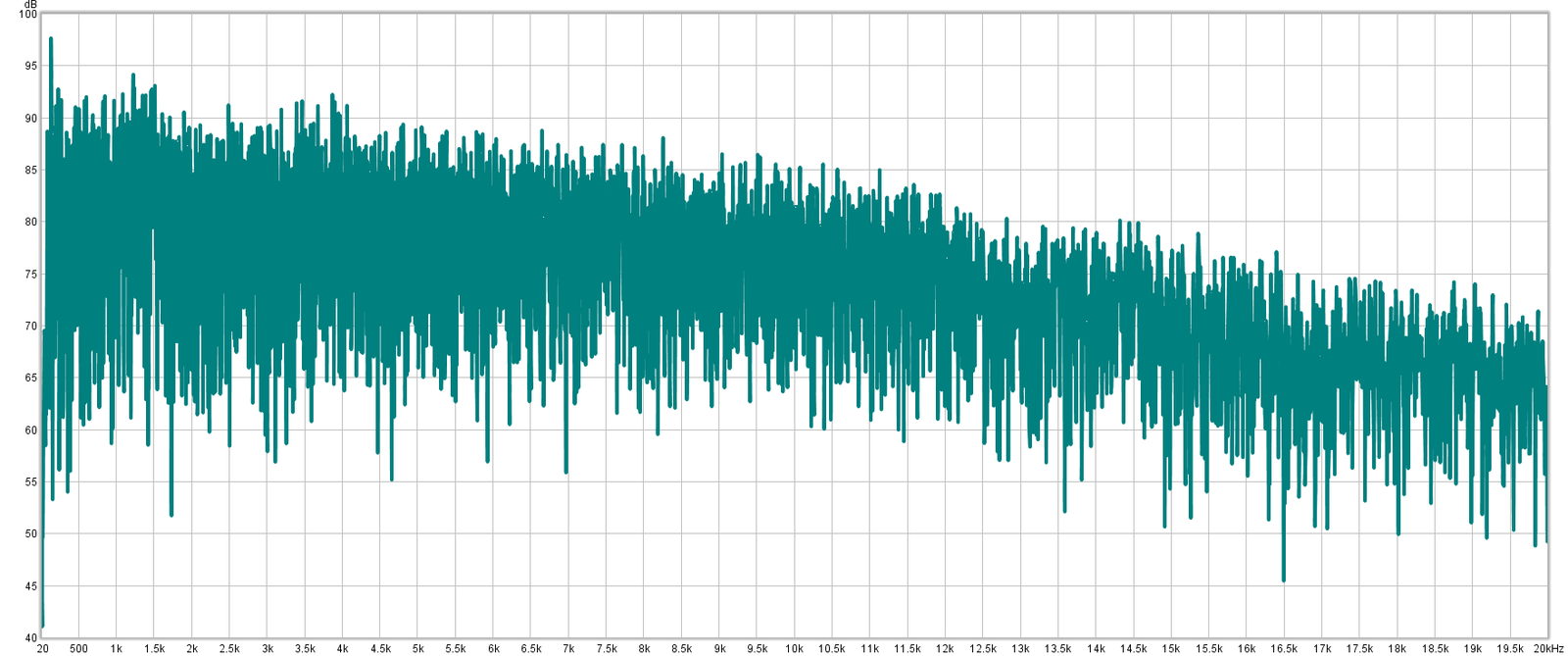



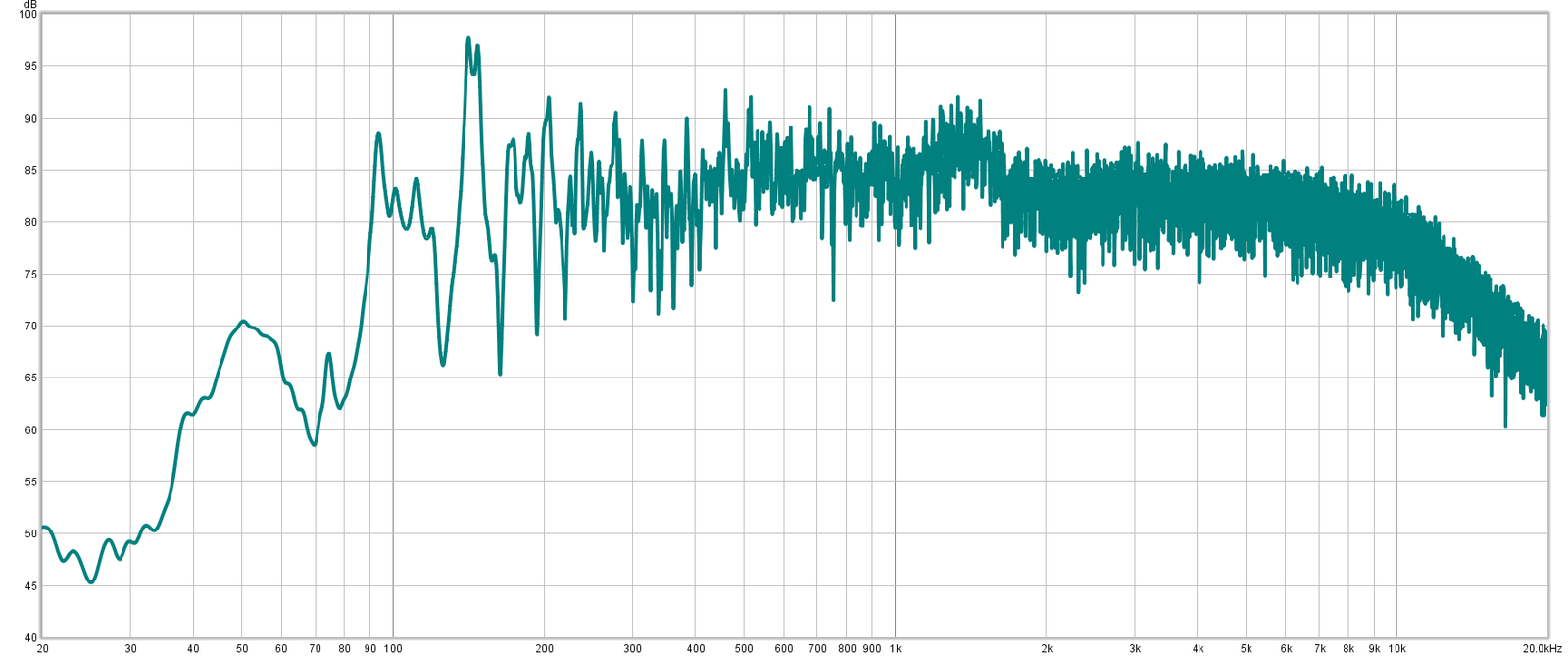
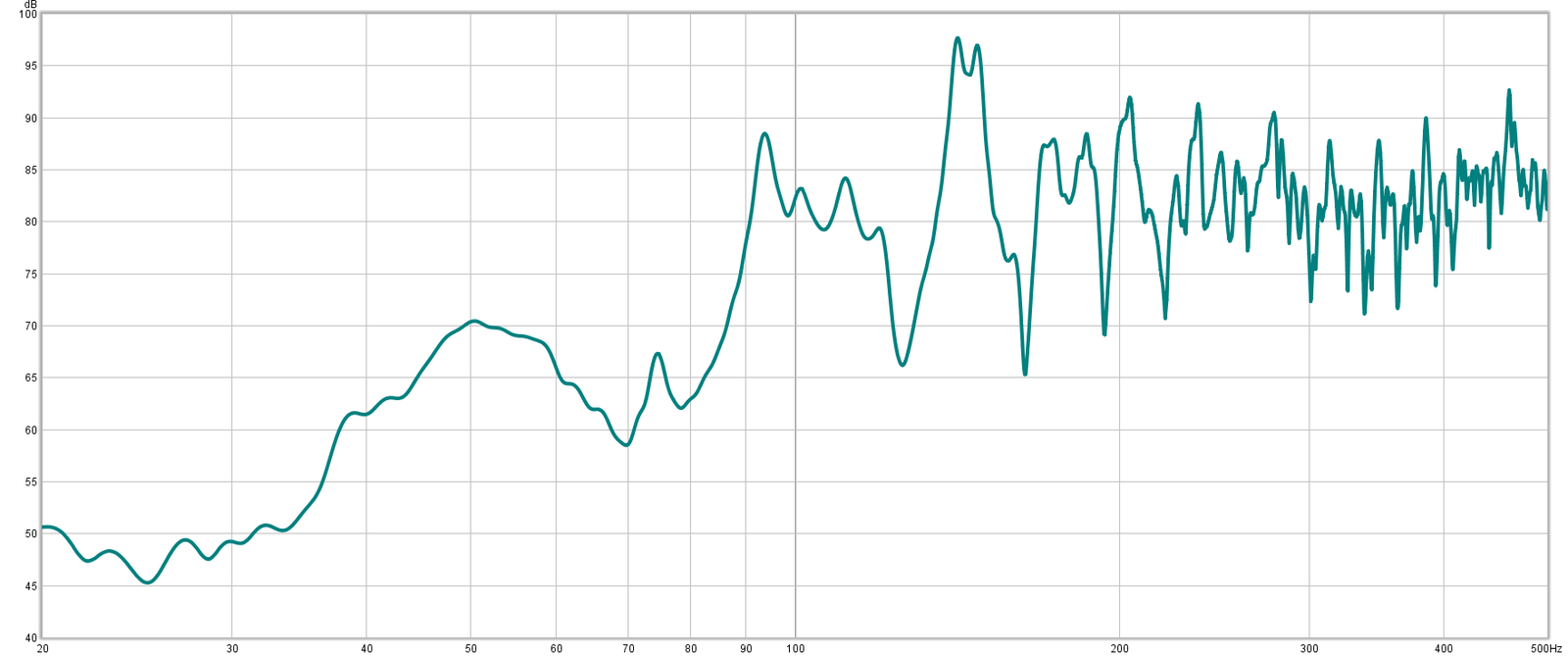
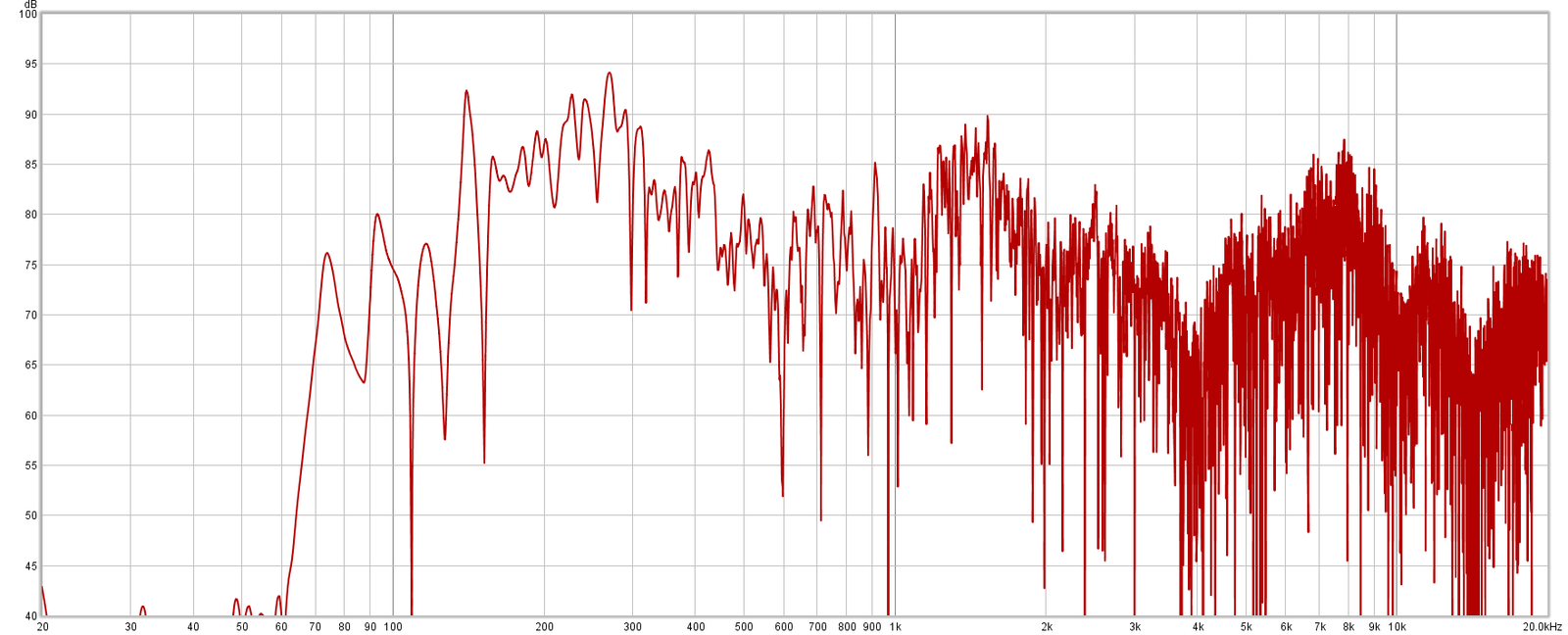



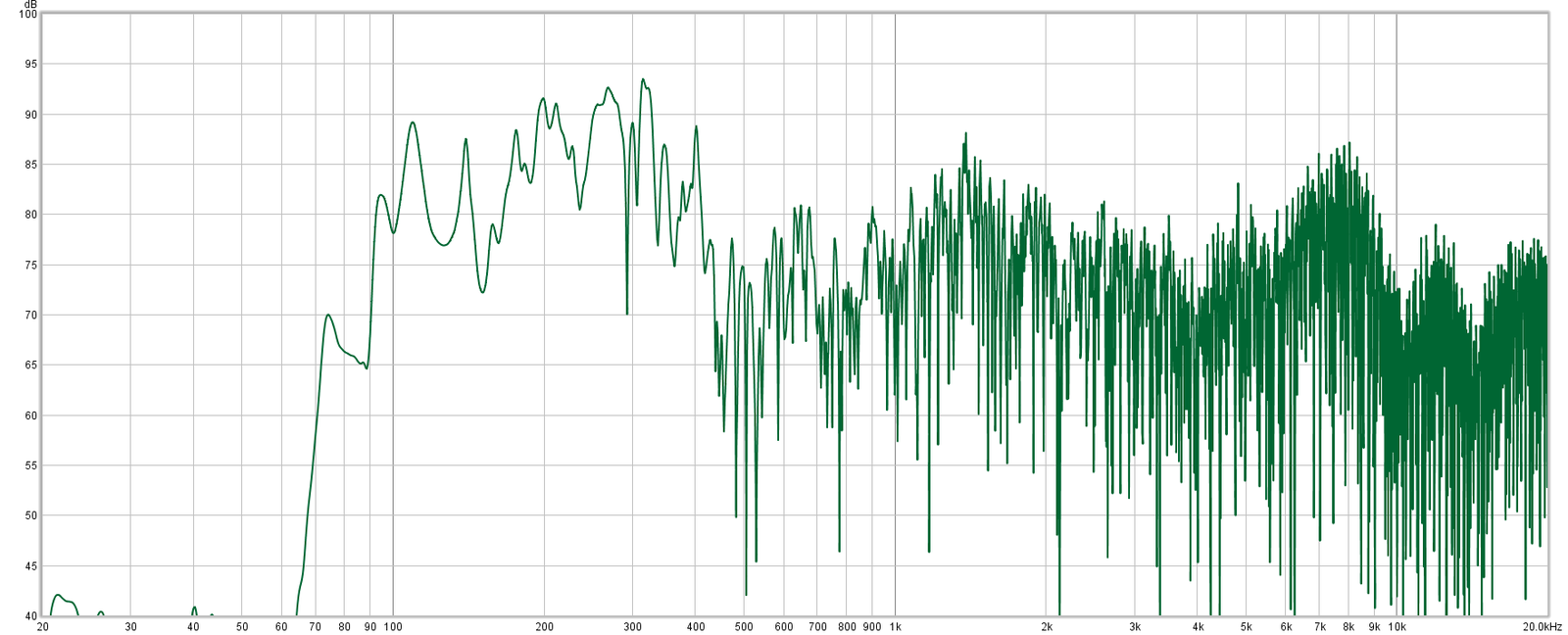
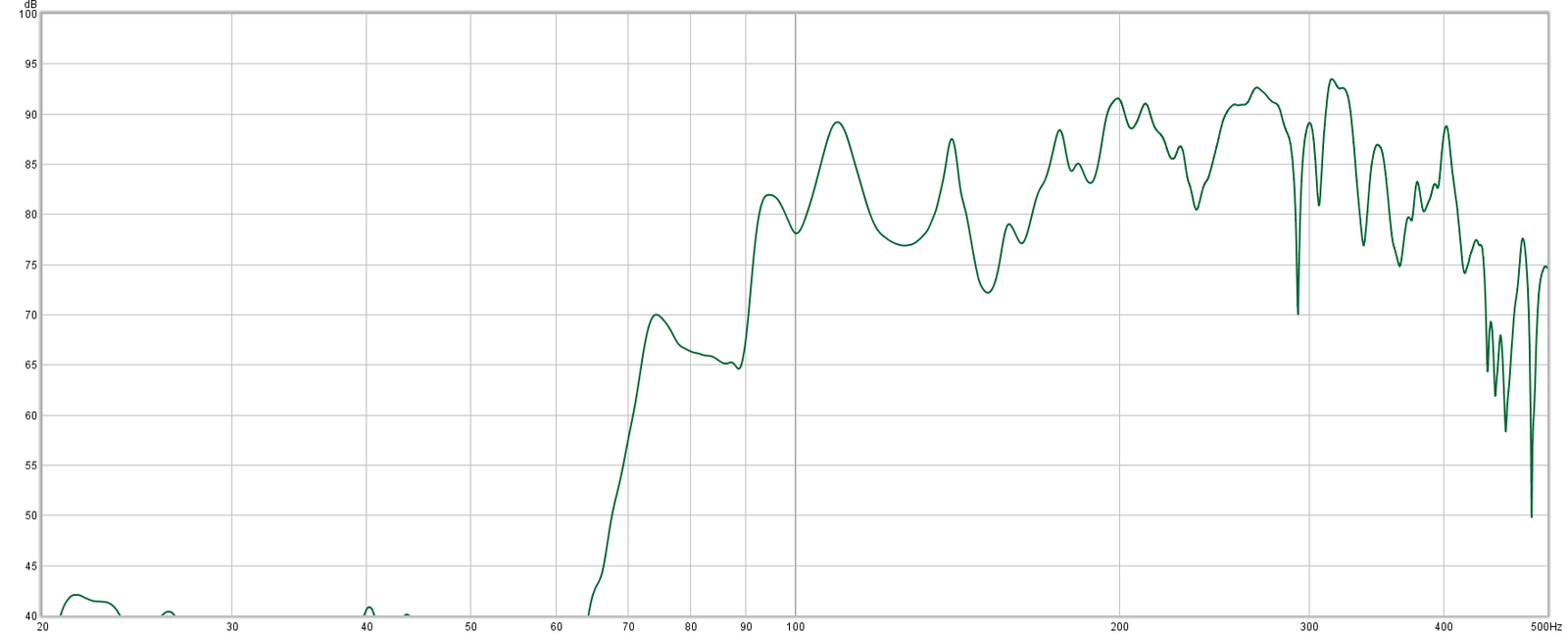

Hey welcome to RO. Im not an expert on reading charts, but ive
Hey welcome to RO.
Im not an expert on reading charts, but ive built several pro studios. Generally there isnt much to read into when the room is untreated.
The most critical area in the CR especially is low frequency response. For this youll want to use a mode calculator to identify which low frequencies overlap with each other, or arent spaced well.
I would strongly consider using the larger room for the Control Room. You can reproduce lower bass frequencies in that room, which is critical for mixing and getting sounds. The tracking has the luxury of moving the mics and instruments around to get the desired response, as well as eq.
It is certainly worth comparing the two rooms on paper.
The biggest problem with your dimensions is the 8ft ceiling. In both rooms i would expect to add absorbers (a ceiling cloud) that covers most of the ceiling.
Your going to want as much bass trapping as possible in the CR, for sure. Ideally in the tracking room too.
Beyond the ceiling cloud and bass trapping, basic RFZ (reflection free zone) treatment is the most conmon approach these days. You sit at the listening basic position (38% deep into the room, centered left to right), witg the speakers set up in sn equilateral triangle off that point. have a buddy slide a mirror along the walls, and anywhere you can see the tweeters, mark as a location for absorption.
In general 25-30% of the room treated with absorbsion yeilds something thats not uncomfortably dry or wet sounding.
The tracking room has more options. Maybe one side live-er the other side deader. It depends much more on taste, and what your tracking in there, and if its live groups. Once the basic bass response and nasty slap echoes and rings are taken care of, much of it is then done by ear.
These are fairly general answers to the broad questions.
I highly reccomend "build it like the pros" by Rod Gervais, as the defacto guide for anyone building a studio.
I would also add that proper, quiet electricity and lighting are critical. I would also consider some sound isolation in case the neighbors change their mind or new ones move in.